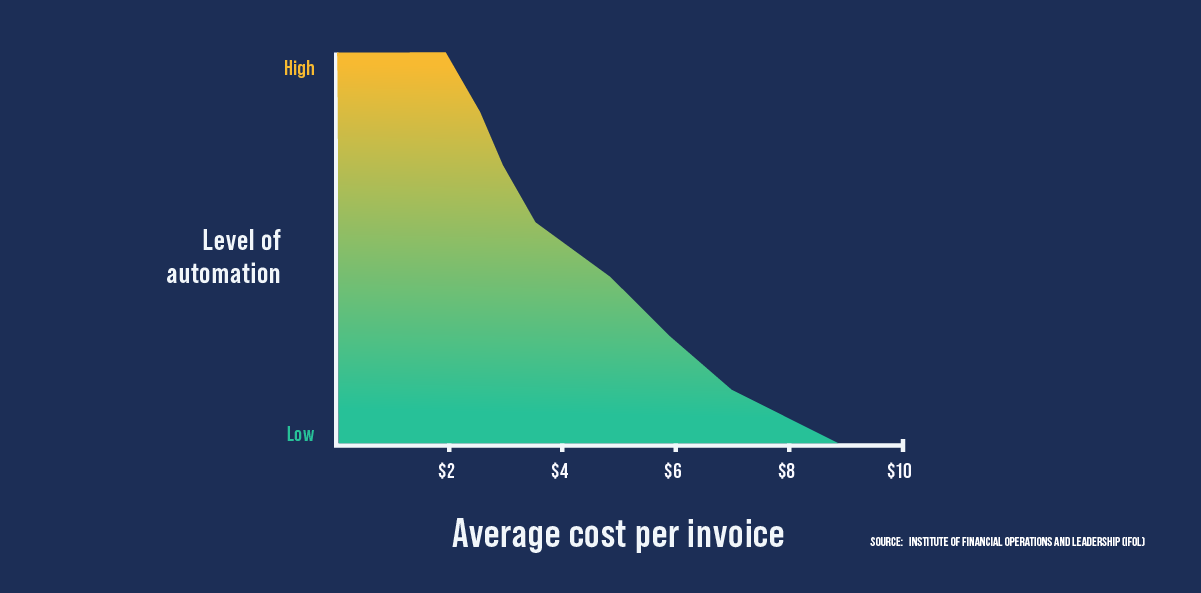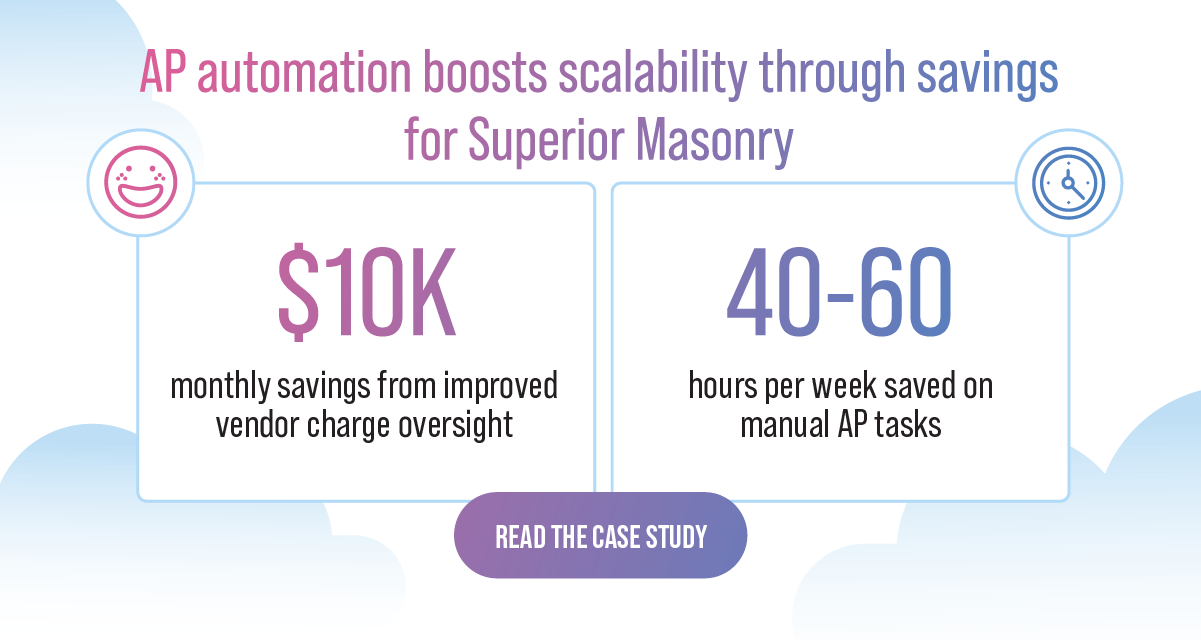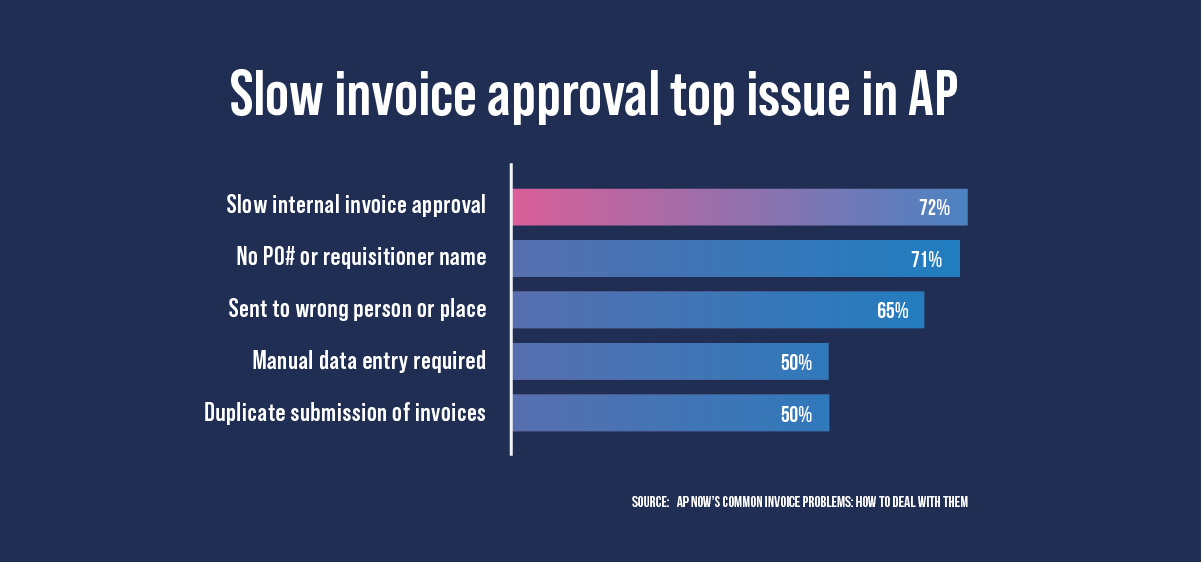4 common invoice problems and solutions — thanks to automation

Invoice processing is fundamental to nearly every accounts payable (AP) operation.
Regardless of the size, industry, or specialty of your business, it’s a task that your AP department likely handles.
However, despite its importance, many companies face a wide range of challenges in executing invoicing effectively.
This is often because of manual, cobbled-together processes and tools that pile up to create information silos, operational inefficiencies, compliance issues, and expensive mistakes.
If you’re a controller, finance manager, or AP leader; you’re not alone in trying to figure out exactly where all your invoice management problems are coming from. We’ve identified several common sources in this article —as well as cases studies of how AP automation has been successfully implemented to solve each.
It’s time to get a handle on your invoice problems and solutions. We’ll show you how to implement AP automation for a more efficient and accurate invoicing flow.
The cost of mistakes due to invoice processing challenges
According to an IDC report, more than half of what AP workers do day in and day out is manual invoice data entry and classification. The American Productivity & Quality Center estimates that manual invoice processing adds up to an annual error rate of 2%.
With these facts in mind, we can make an educated estimation that most businesses have a 2% invoicing error rate.
Sure, that doesn’t really sound like a lot.
But say your business is among the 48% that process 500 invoices each month. That’s 10 invoices getting paid late, incorrectly, or duplicated every single month. In a year, you’re looking at 120 separate times where you missed out on saving money, made an uninformed financial decision, flubbed an important opportunity or relationship, or just flat-out lost money.
Want to figure out how your invoice management process measures up?
You can calculate your rate of yearly invoice mistakes by dividing the number of invoices with mistakes by the number of invoices processed annually. Multiply your answer by 100 to get the percentage rate.

Now that you know how often your AP department is facing mistakes in their flow, and how that compares to the 2% benchmark, you can decide if it’s time to suss out and fix your invoice processing challenges.
Up for the journey?
Then let’s explore various ways you can solve four common invoicing problems —all using AP automation.
Automation as an AP cost-cutter
Invoice automation leverages technology to streamline the process of collecting, verifying, approving, and sometimes even paying invoices with little to no human intervention.
Of course, for most businesses, putting a system like this into place is going to cost money. And what does it mean for your valued employees in the AP department?
The truth is, yes, AP automation tooling does require an upfront investment, but it’s all in the interest of saving money (and employee sanity!) down the line.
Automation is pivotal in accelerating the invoice cycle, and cutting down on human errors and fraud at the same time. That means quicker, more accurate payments that lead to better early payment discounts, eliminated late fees, and healthier vendor relationships that may get you on the ground floor when it comes to new savings opportunities.
Just consider that the average cost of paying an invoice in a well-automated company is just $3.40, while it’s more than double at $7.90 at businesses that are light on automation tech.

On the other side of the same coin, automation also makes for less manual labor on mundane tasks like data entry, invoice verification, matching, searching for duplications, chasing down approvals, and so on. So even as your business, and your invoice volume, grows —your headcount doesn’t have to.
By managing and speeding up the more repetitive elements of invoicing, AP and invoice automation reduce both mistakes and time —saving you money. This enables your smart AP team to better use their expertise on cash flow and supplier relationship management, controlling costs, mitigating risks, and analyzing AP data to find trends and insights that can assist business growth.
How to solve 4 common invoice problems using automation (with examples)
Let’s zoom in on a handful of common problems that occur when it comes to managing and handling invoices. We’ll look at examples of real companies that have experienced them, and how each issue can be solved by applying AP automation.
Delayed and inaccurate month-end closes skew business finances
Month-end close is a crucial accounting process that finalizes financial records at the end of each month. It’s important to review and reconcile these records regularly for accurate financial analysis and business decision-making.
In the case of Beyer Mechanical, manual processes made it nearly impossible to close the books each month.
At Beyer Mechanical, 1,500 invoices needed to be manually coded, verified, matched, and routed for approval monthly. It was never done on time because leadership couldn’t get a clear picture of business performance and had to make many blind, critical financial decisions.
But after the integration of Stampli’s smart AP automation platform that actually works with their enterprise resource planning (ERP) system Sage Intacct, Beyer Mechanical’s small-but-mighty AP team was able to apply automation to invoice capture, coding, approver selection, and sending approved invoices to Intacct for payment.
This led to the firm finally being able to close their books on time, get invoices approved sixty times faster, and process invoices in 60% less time. Best of all, their AP workers became less like spreadsheet operators and more like knowledgeable, engaged managers with more power to inform and influence business financial decisions.
Paper invoicing stunts business growth in various ways
We probably don’t have to convince you that paper invoicing presents several significant challenges that can damage your ability to grow.
Paper invoices are:
- Error-prone due to manual data entry during intake.
- More labor-intensive to get reviewed, approved, and paid than their digital counterparts.
- Easily lost as they have to be transported, sorted, and safely stored.
- Hard to thoroughly match against the corresponding purchase order (PO) and receipt to stave off fraud.
- Slow, traveling across desks and through the mail, ruining your chances for early payment discounts.
- Usually limited to traditional payment methods, such as paper checks.
In other words, accepting and processing paper invoices has a way of keeping your business stuck in the past and stunted when it comes to the capital and financial data you need to scale.
Of course, replacing paper-based systems is at the heart of AP and invoice automation software.
Before automation, Superior Masonry was drowning in paper billing and no system which “created a ripple effect of inefficiencies” that led to a fuzzy understanding of revenue and uncertainty around investing back into their growing firm.
But after onboarding Stampli — the only AP automation provider validated and certified by Sage for Sage Intacct Construction — our AI system began recognizing vendor names, invoice dates, and invoice amounts in just a week. The result was taking invoicing processing from weeks to a day and saving Superior Masonry thousands per month in invoice mistakes.
With paperless invoicing processing, any size business in any size organization can gain the accuracy, speed, and insight needed to grow more profitable.

Slow, error-riddled payments damage vendor relationships
If your AP team tends to be on the slow side when processing invoices, you may know how much this can adversely impact vendor relations.
Payments that are made after the due date, inaccurate, or both can have significant negative consequences for a business, particularly in how vendors view them. Aside from the erosion of trust and industry reputation, you may find more and more suppliers who are wary of working with you and offering discounts. And of course, there are the very tangible late fees that may result!
And this isn’t something simply hiring more AP workers can always fix —for most companies it’s a systemic issue.
The Los Angeles Area Chamber of Commerce is a perfect example.
Before AP automation software, the organization sent payments via mail. This meant they were regularly late or lost, causing security concerns, fees, lost trust, and expensive duplicate payouts.
But after revamping its system to include Stampli’s invoice processing, payment workflow, and credit cards —the LA Area Chamber of Commerce is meeting payment terms and enjoying improvements in both internal operations and vendor relations.
This is a prime example of how applying automation in the invoicing process —even when you may have to uphold some of the bureaucratic processes that come with your industry, such as government — can improve the accuracy and speed of payments.
Tardy invoice approvals rack up fees and missed discounts
You can probably think of plenty of issues in your AP process. According to AP Now’s report Common Invoice Problems: How to Deal With Them, for the majority of invoicing pros, slow approval times are the top concern.

The AP personnel at Spanish Fork City faced this stumbling block during COVID when everything went remote. Already dealing with approval for more than a thousand invoices every month, the city needed a smarter solution for handling the invoice approvals, data entry, and file storage they were doing physically and manually.
Now by using a combination of Stampli’s AP automated invoicing software and Caselle’s government accounting software platform, the city’s AP team has visibility into invoices the day they’re received and smart systems in place that build on their unique patterns to get invoices processed faster. Their new automated invoice approval flow makes it easy to assign invoice approvers, program the approval order, send approval reminders, reroute invoices as needed, and slip the invoice right back into the flow when they’re ready for final review and payment.
Today, thanks to automation, Spanish Fork City has doubled how fast invoices move through the lifecycle with a whopping 12x increase in speed to authorization.
How much could automation save your business on early payment discounts, late payment fees, and all the labor associated with getting hundreds (or more) invoices approved every month?
Automate away from invoice issues with Stampli for AP
Our research in partnership with Probolsky Research uncovered something encouraging: 80% of AP teams have already implemented some element of automation.
However, just 18% have full automation.
It is clear that automation is one of the best solutions for overcoming the most common invoice challenges businesses face.
The breakdown often lies in implementation.
If you’ve ever wondered how you can reinvent your entire AP system without bringing your business to a standstill, we’ve thought about it a lot.
The Stampli AP automation platform doesn’t disrupt your ERP or upend all your existing AP processes, it adapts. Between the smartest AI in the game (meet Billy the Bot), award-winning customer support, and integrations like you wouldn’t believe, Stampli boasts the fastest and most satisfying onboarding experience in the industry.
And with Stampli Cognitive AI™, your team is freed from PO matching. Once this cutting-edge feature has a little time to learn your processes and preferences, it can take on the matching automatically. Your team naturally still has oversight into the system, but they also win back tons of time to be spent on thoughtful, strategic work.
With Stampli, AP and invoicing are never an afterthought. And we’re always finding ways to provide more services — most recently our cutting-edge payments, credit cards, and vendor management features.
If you see your own invoice challenges reflected here and believe automation could be the solution you’re looking for, sign up for a free demo and let one of our AP experts help you find your groove today.